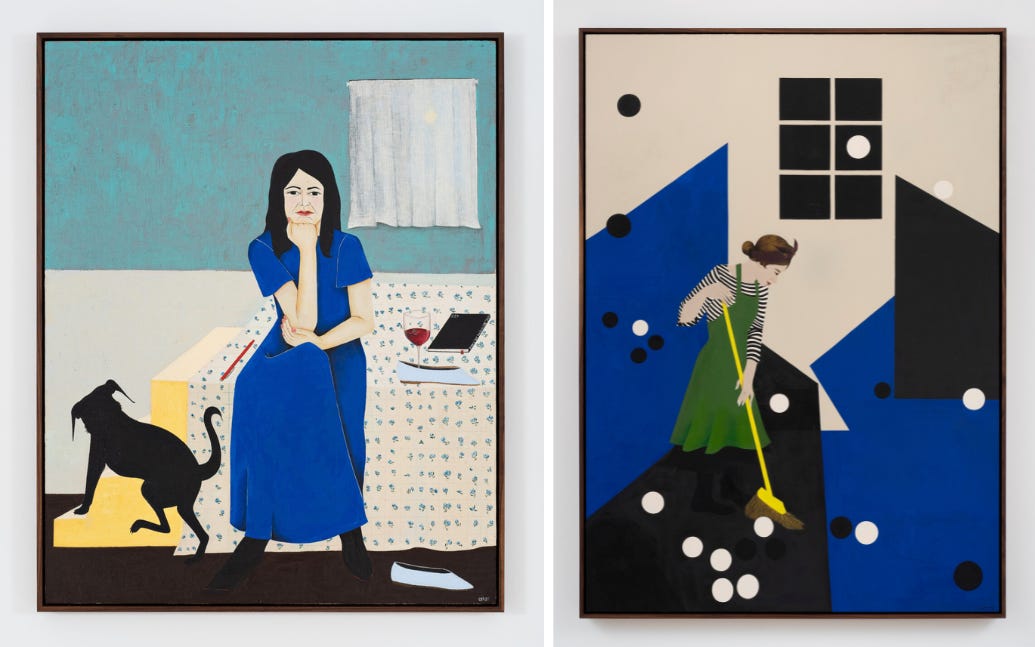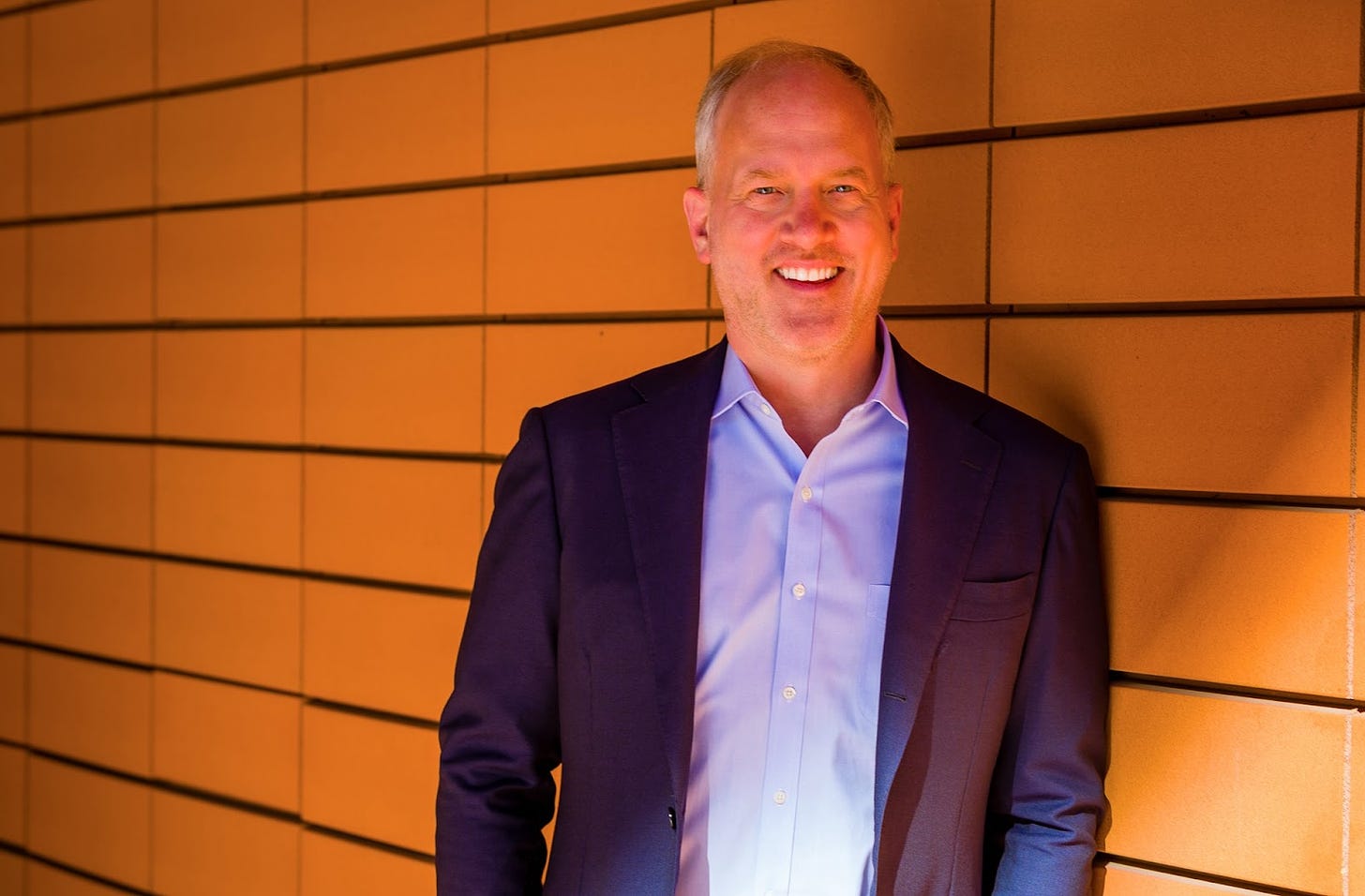Unlocking modern art
Analyzing art is a personal process, but these insights from a museum director can help make it a more meaningful one
The following article appeared in the Sept. 21, 2024 edition of The Charlotte Ledger, an e-newsletter with smart and original local news for Charlotte. We offer free and paid subscription plans. More info here.
Bechtler Museum executive director Todd Smith shares tips on how to better understand and appreciate contemporary art; Is art ‘a window, or is it a mirror?’
Clare Rojas’ paintings entitled “Tired of thinking” (left) and “Sweeping Away the Static and Negative Energy” will be on display along with 90 others at the Bechtler Museum of Modern Art from Sept. 21 through Jan. 20. (Photos courtesy of Bechtler Museum)
by Lindsey Banks
Looking into the eyes of the woman sitting in artist Clare Rojas’ painting entitled “Tired of thinking,” Todd Smith contemplated how the woman wasn’t sliding off the bed at that angle, why her wine glass was nestled in her shoe, and if her diary, with “tired of thinking” etched on the spine, was in fact a diary.
“Is she an artist? Is she a writer? Is she just someone who enjoys taking notes?” Smith pondered out loud. Smith is the executive director of the Bechtler Museum of Modern Art in uptown. The “Clare Rojas: Past the Present” exhibition runs today through Jan. 20 at the museum.
Art is meant to push its viewers to look at the world differently, Smith told me on a recent trip to the museum. Sometimes, it makes you uncomfortable and provides more questions than answers. Art challenges you to look inwardly, he said.
But how? How is a painting of a woman in a blue dress, sitting on a bed with a dog at her feet and a wine glass in her shoe supposed to make me see the world and myself differently?
I understood the concept, but sometimes, looking at a piece of modern or contemporary art makes me feel like I’m banging on the outside of a window, watching others reach enlightenment through the smudged glass.
That afternoon at the Bechtler Museum, I set out to be let in.
There aren’t any sure-fire steps or instructions on how to take in art and reach an understanding, Smith explained.
How one analyzes art is completely up to them — whether they choose to recognize the emotions or memories that arise while gazing at a piece; whether they spend their time admiring the direction of the brush strokes and wondering how the artist came up with the concept; or whether they question the logistics of the scene, like the full glass of wine in a shoe that would surely topple over in real life.
But the first step, Smith said: Meet the artist halfway.
“You don’t have to agree with the artist,” he said. “You can, at the end, but you sort of have to meet them and say, ‘OK, what are they trying to do?’ And the second thing that I always think about is, is the work of art a window, or is it a mirror? Meaning, is it a window into something you don’t know, to a new place, or is it a mirror back on you?”
Todd Smith became executive director of the Bechtler Museum of Modern Art in 2020. The Bechtler Museum was opened in 2010 by Charlotte resident Andreas Bechtler, whose parents, Bessie and Hans Bechtler, began collecting modern art in the 1950s. (Photo courtesy of the Bechtler Museum)
Expand your definition of ‘art’: For those who don’t think art is meant for them, the understanding might come from broadening the definition, Smith said.
“If you think about architecture, you think about design — those are all now art forms that museums celebrate and showcase,” he said.
From the moment you walk into the Bechtler, the atmosphere shifts. It’s intentional, Smith said. Having a grand lobby serves as a transition from the bustling, noisy streets of uptown to the quiet, thoughtful openness of the gallery.
A mural is displayed over the Bechtler Museum front desk, a piece by minimalist artist Sol LeWitt called “Wall Drawing #995 Color Geometric Form.” The mural, which is painted directly on the wall, isn’t the original copy, of course. Actually, an original copy doesn’t exist, Smith said.
Sol LeWitt’s creation is actually a set of written instructions (with a few sketches) on how to recreate the painting.
Take note of what catches your eye: Colors, objects, textures, techniques, emotions, memories — there’s no wrong answer here, Smith said.
“If you look at just a straightforward landscape, even one that looks like the world around you, there might be a color, like a shade of green in that painting that resonates with you as you're looking at it,” Smith said. “And you go outside, and all of a sudden, you see that green somewhere on your walk around your neighborhood in a way that you hadn't seen before.”
Art can also make you feel nostalgic, he said. It can conjure up memories and associations — a Thanksgiving dinner from your childhood, a pattern that resembles your grandmother’s couch or a lyric from your favorite song. That longing can translate into an array of emotions.
Ask questions: If you want to take it a step further and try to understand what influenced or inspired the artist, ask questions — even if you don’t think they’ll be answered.
Taking in a painting is no different than listening to a song for the first time, Smith said, or reading a book. If you’ve ever flipped past the acknowledgment page, some books have “book club” questions listed in the back — questions written by the author to get readers thinking and reflecting on the work.
Some artists will include questions or a background story on a plaque next to the work, which can help viewers get the ball rolling.
Bechtler Musuem’s gallery attendants are trained to be knowledgeable about the art, which is typical at about half of art museums, Smith said. They can give background information on the art and answer some of your questions.
Whether you inquire silently to yourself or have a conversation out loud with whoever is near you, Smith says he usually asks:
Can we know what the artist was trying to do, what their intent was, and if it's historical?
What do we know about that moment in time? What were they thinking about? Were they on one side or the other in politics, economics or education?
Were they appealing to a certain donor, patron or someone who buys the work?
How does that intent get translated into the work?
In the end: Is it successful?
Determining success: There are many ways to evaluate success, Smith said, beyond just the overall attractiveness or neatness of the art.
“If I think the artist's intent was to create something that was purely abstract, does it?” he said, “or [if the artist’s intent was to] evoke an emotion, does it? Change my view on something? Do I believe the story?”
And, if you determine the painting was not successful, that’s OK, too. Art is subjective.
Looking into the eyes of the woman sitting in artist Clare Rojas’s painting entitled “Tired of thinking,” I saw someone annoyed and fed up, breaking the fourth wall, staring at me as I stared at her. Tired of being a spectacle, hanging on the wall for those coming to her for answers.
I felt her tiredness, but moreover, I felt inspired. I also wanted her bedspread. Success.
Lindsey Banks is a staff reporter for The Ledger: lindsey@cltledger.com
Need to sign up for this e-newsletter? We offer a free version, as well as paid memberships for full access to all 4 of our local newsletters:
➡️ Opt in or out of different newsletters on your “My Account” page.
➡️ Learn more about The Charlotte Ledger
The Charlotte Ledger is a locally owned media company that delivers smart and essential news through e-newsletters and on a website. We strive for fairness and accuracy and will correct all known errors. The content reflects the independent editorial judgment of The Charlotte Ledger. Any advertising, paid marketing, or sponsored content will be clearly labeled.
Like what we are doing? Feel free to forward this along and to tell a friend.
Social media: On Facebook, Instagram, Twitter and LinkedIn.
Sponsorship information/customer service: email support@cltledger.com.
Executive editor: Tony Mecia; Managing editor: Cristina Bolling; Staff writer: Lindsey Banks; Business manager: Brie Chrisman




